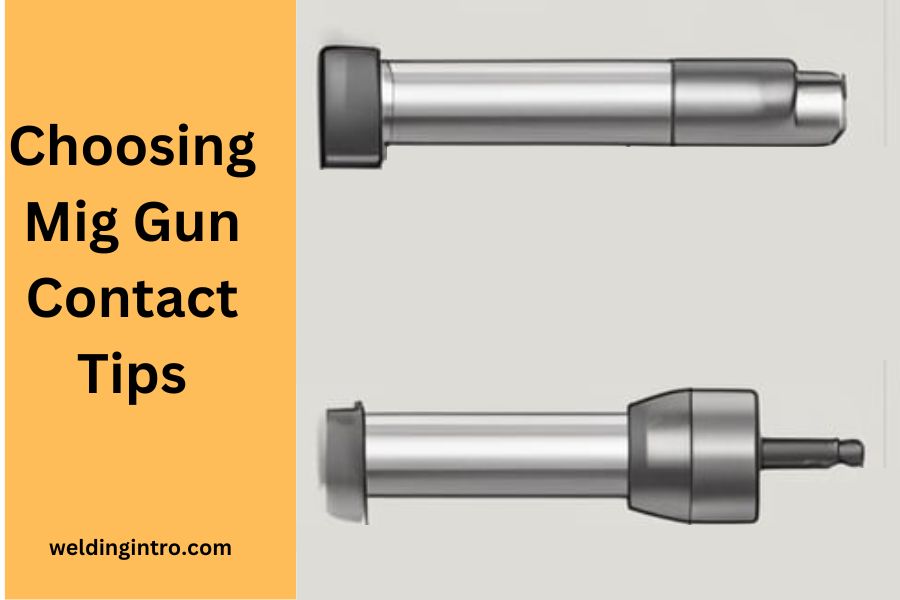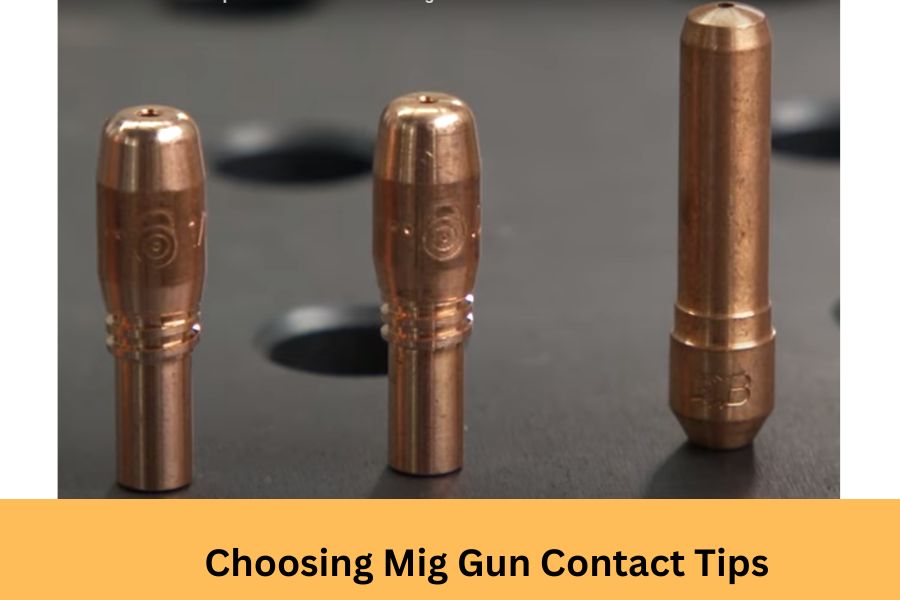Think of the contact tip as the welding torch’s fingertip in the mig welding process. It’s the part at the very end that touches the welding wire at one edge and the workpiece at the other. This tiny buddy is all about making sure the wire meets the work metal in just the right way.
Factors such as wire diameter, material thickness, and welding amperage can all impact which contact tip is best suited for your welding needs. Additionally, properly maintaining and replacing your contact tips can help prolong their lifespan and ensure consistent weld quality.

Selection Criteria
Choosing the right contact tip for a MIG welder gun is crucial for achieving quality welds. The following factors should be considered when selecting the contact tip:
Selecting the right material
There are five types of contact tips. Each of them are made from different materials. They are
- Standard Copper
- Copper-Chrome-Zirconium
- Silver-Plated
- Heavy Duty Silver-Plated
- Stainless Steel
For general mig welding, a standard copper tip is enough. It provides good thermal conductivity which allows smooth flow of consistent electricity to the wire. Also it stabilizes the arc resulting in a well penetrated welding.
Chrome zirconium copper tips are harder than standard copper tips and they are used for robotic welding applications. In automated welding arcs increase on time which require a solid tip to withstand the increased heat. Here chromium zirconium tips do a great job.
For robotic application silver plated tips are also a great choice. Silver has more electrical conductivity than copper. So electric arc supply is more curated than standard copper.
It helps reduce the micro- arcing while extending the lifespan of the tip. And the quality of welding increases far higher. For welding aluminum alloy, heavy duty silver plated tips are a better choice.
Stainless steel tips are great for reducing the premature wear and tear of contact tips. However it is not as conductive as silver plated or copper tips.
Undersize vs Oversize
Contact tip must match the wire size for better welding results. However, sometimes undersized tip become necessary for improving weld quality. This happens when solid wire is fed from the drum. In this case the wire is fed with less or no contact which creates more pressure on the wire. And in turn increase electric conductivity.
Under-sizing is not a wise option in general. Doing so can lead to friction creating erratic wire feeding and potential burn back
On the other hand, oversizing tips can lead to burn back more frequently. Because it decreases the welding current transfer and increases tips temperature. If you face an oversizing issue, resize the tip or recess to make it compatible with the application.
Contact Tips Size Matters
Contact tip size refers to the thickness of the mig wire. We know that the mig gun feeds the wire through the tip. For thicker wire, the welding gun will generate more heat and for thinner wire it will produce less heat. The heat input determines the level of penetration the weld will have after welding.
Wire sizes generally range from 0.024″-0.094″. For larger ones, it takes less time to complete the weld and for shorter ones it takes higher time to weld on an application. So the choice of wire thickness depends on the application you are working with.
For applications like construction work, where more power and heat is required, use of thicker size tips would do the work quickly and perfectly. For welding car sheet bodies, a thinner tip would be sufficient.
Contact Tip Recess
The position of tips within the nozzle is referred to as contact tip recess. The wire can stickout (electrode extension) of the nozzle. Increased recess leads to higher voltage level as the stickout becomes longer.
This creates an arc problem resulting in less arc. So for more stable arc and low voltage penetration, short wire stickout is preferred.
A correct recess reduces the system loss, burn through, warping and porosity as well as spatter. It also reduces the chance of premature contact tip failure. There are different recess sizes for example ¼ inch recess, 1/8 inch recessed flush and 1/8 inch extension.
Each position requires different modes of welding, amperage and gas requirements.
Amperage and Duty Cycle
The amperage and duty cycle of the welder should also be considered when selecting the correct contact tip. Higher amperage requires a larger contact tip to accommodate the increased heat and wire feed.
Duty cycle refers to the amount of time the welder can operate continuously without overheating. A contact tip that is too small can cause the welder to overheat and reduce the duty cycle.
Maintenance and Replacement
Signs of Wear
Signs of wear include a flattened or deformed tip, a build-up of spatter, and a rough surface texture. If any of these signs are present, it’s time to replace the contact tip.
Regular Maintenance Tips
Regular maintenance of the contact tip can help prolong contact tip life and ensure optimal performance. One important maintenance tip is to clean the contact tip regularly. This can be done by using a wire brush or a specialized cleaning tool.
It’s also important to check the contact tip for any signs of damage or wear before each use. Additionally, it’s a good practice to inspect the wire feeder and liner regularly to ensure they are clean and free of debris.
Optimal Replacement Intervals
The frequency of contact tip replacement depends on the frequency of use and the type of welding being performed. Generally, it’s recommended to replace the contact tip after every two spools of wire or every eight hours of use.
However, if the contact tip shows signs of wear before this interval, it should be replaced immediately. It’s also important to choose the right contact tip size for the wire being used to ensure optimal performance.
Lastly
Contact tips are a crucial element for mig welding. Choose a correct tip for high quality weld. Make sure you match the tip with the nozzle and solid wire before starting the welding. Consult a professional expert for any confusion.
Sources
